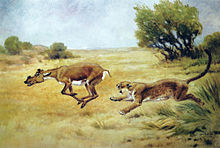Dinictis
| Dinictis | ||||||||||||
|---|---|---|---|---|---|---|---|---|---|---|---|---|

Skeleton of a Dinictis in the Royal Ontario Museum in Toronto |
||||||||||||
| Temporal occurrence | ||||||||||||
| Upper Eocene to Lower Miocene | ||||||||||||
| 38 to 20 million years | ||||||||||||
| Locations | ||||||||||||
|
||||||||||||
| Systematics | ||||||||||||
|
||||||||||||
| Scientific name | ||||||||||||
| Dinictis | ||||||||||||
| Leidy , 1854 | ||||||||||||
Dinictis belonged to the Nimravidae family, an extinct family of predators , also known as "false saber-toothed cats". Dinictis livedin North America from the late Eocene to the early Miocene .
The genus was given the name Dinictis in 1854 by the American paleontologist Joseph Leidy .
anatomy
Dinictis had a slender body about 1.1 meters long and short legs about 60 centimeters long. He could only partially retract his claws, but had extremely strong jaws and a long tail. He was very similar to his relative Hoplophoneus . Compared to those of the related species Eusmilus and the saber-toothed cats from the Felidae family , its upper canine teeth were relatively small, but still clearly protruding from the mouth. Under the tips of the canines, his lower jaws spread out in the shape of a club.
Dinictis looked like a small leopard and apparently his way of life was similar to that of a leopard. However, this does not indicate a close relationship, but rather the occupation of a similar ecological niche . Unlike modern cats , Dinictis was not a toe walker . As a sole walker , this species could not sneak up well. It lurked in the thicket for passing game.
distribution
Fossil finds in Saskatchewan , Colorado , Montana , Nebraska , South Dakota , North Dakota , Wyoming, and Oregon indicate that Dinictis lived in what is now the United States and Canada .
Web links
- Dinictis - prehistoric-wildlife (English)
- Dinictis - dinosaurs.about (English)
